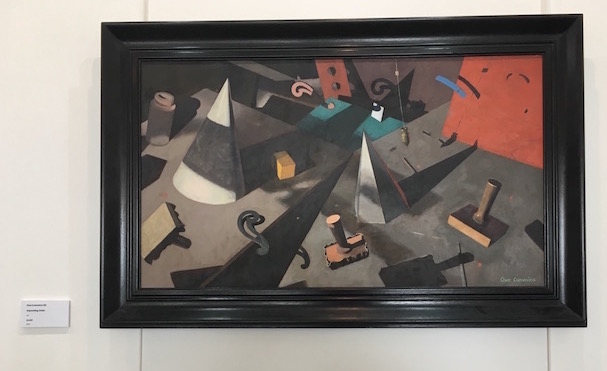art/architecture

IN THE LIGHT OF SURREALISM #2 and INVERSE REFLECTION, the two exhibitions opening at the Arts Forum this week, draw, consciously or unconsciously, on tenets of surrealism. One of the most influential cultural movements of the twentieth century, surrealism continues to inspire artists today. But what does it mean? ‘I think the word is too commonly used and, in the wrong context, most of the time,’ says Jo Welsh, curator of In the Light of Surrealism #2. ‘It’s something out of the ordinary, something that makes you think.’ And, certainly, both exhibitions do that.
The follow-up to a 2012 AF show, also curated by Welsh, In the Light of Surrealism #2 has an impressive line-up of artists, including Antony Penrose (son of Roland Penrose and Lee Miller), Royal Academicians Brian Catling, Gus Cummins, and Mick Rooney, and Kathleen Fox, Jane Hoodless, Jo Redpath, Kathrine Reekie, Tim Riddihough and Jacob Welsh (Welsh’s son).

Above image: Impending Order by Gus Cummins
The featured 2D and 3D works complement one another. Many have common threads such as the sea, found objects and absurd or fantastical creatures or dreamscapes. Jane Hoodless’ rather fascinating pieces incorporate hair – some human, found in an abandoned box in London. Hair Receiver, in particular, calls to mind the work of René Magritte. Similarly, Jo Redpath’s imaginative 3D art, such as the visually striking procession of Crabmen, striding confidently towards a small door in the gallery wall, are reminiscent of Dali.
Gus Cummins’ paintings, by contrast, are much quieter, but no less unsettling. The stillness of Impending Order, with its geometric shapes and suspended pendulum, is palpably menacing. And in Antony Penrose’s Stigmata, we see three controversial capitalist leaders of our time, Theresa May, Donald Trump and Vladimir Putin, represented, as cutouts, in a glass cabinet. Only their faces and raised right hands are shown, the blue-coloured palms exposed, each carved with the symbol for the pound, dollar and rouble, respectively. The piece calls to mind fortune teller automata of the past.
A sense of disquiet is also evident in Inverse Reflection, the exhibition in AF’s second gallery. Inspired by a series of conversations between artists Sally Meakins and Lorrain Mailer, which covered such themes as migration and slavery, the works can almost be seen as a call and response. Mailers’ stunning Sing a Song of Sixpence, made up of four-metre drop roller blinds with two-way mirror film, suspended from the ceiling, at first seems to dominate the room. Each hanging is inscribed with a swarm-like mass of stick figures which also recurs in Mailer’s 2D wall-hung work.
While Mailer’s works are light in colour and have a feeling of space, Meakins’, in contrast, are darkly sinister, often claustrophobic in feel. Arms protrude from walls, hands cupped to hold objects – boats made of coloured, moulded wax, keys, feathers; a shiny house with fused windows and doors sits with a ladder leading up to the sky behind it; an iridescent metal bird is pinned through the heart to the wall with a nail; a metal box, itself positioned in a crate lined with bark, seemingly cocoons a black lead balloon. Each piece raises questions about who or what lies within.
There is a fluidity to In the Light of Surrealism #2 and Inverse Reflection, one exhibition moving seamlessly into the other. At times absurd, amusing and unsettling, both feature some exceptional pieces of work. And it’s a credit to the cultural climate of St Leonards and Hastings that such art is being exhibited here.
In the light of Surrealism #2 and Inverse Reflection: 8 August–3 September 2017: Hastings Arts Forum, 36 Marina, St Leonards on Sea, East Sussex, TN38 0BU. Telephone: 01424 201636
A version of this article was published in the HIP, 18 August 2017 issue (print and online).
Credits/copyright: Quote from Jo Welsh (taped interview with A. Vasudevan, 8 August 2017); Impending Order by Gus Cummins (photo by A. Vasudevan).
Also of interest: ‘More than just words – The Jane Eyre Project‘; The hyper-reality of Marcus Harvey’s world – Inselaffe‘; Farley Farm House, Lee Miller and Roland Penrose’s house and the home of the Lee Miller archive.
This review is copyright © 2017 by The Literary Shed. All rights are reserved. All opinions expressed are our own. If you wish to reproduce this piece, please provide the necessary credit. Thank you so much. We welcome your feedback.

